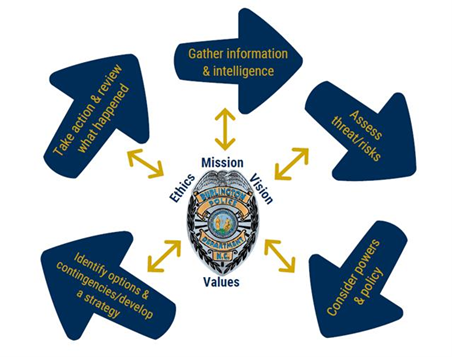Promising Practice:
How the Burlington, NC Police Department Uses the CDM


The Camden County, NJ Police Department was one of the first agencies to integrate the Critical Decision-Making Model (CDM) into its policies, procedures, and training. Other agencies have followed suit.
The Burlington, NC Police Department customized the CDM for its agency. Here are five ways the department is using the CDM:

Remedial Training:
Following an individual incident, a supervisor or training staff member may sit down with an officer or other employee to work through the event using the CDM. The CDM provides a structured way to review incident from start to finish. This process allows the employee to better understand their decision-making, and repetition with the CDM helps it to become a natural process.
After Action and Debriefs
The Burlington PD also uses the CDM in After Actions and Debriefs of critical incidents. In going through the event, the department typically uses a first-line supervisor as the facilitator. The goal is to help everyone involved to understand both their legal authority to be involved in the incident in the first place and why decisions were made along the way. The CDM allows for reflection on how and what information was received and processed, risks present or posed, and how they were assessed. Further, the CDM provides a structured way for evaluating what actions were taken, what the results were, and how the incident was brought to a conclusion. This allows for misinformation, missteps, successes, and pitfalls to be uncovered and discussed, and for any corrective steps to be identified.
Vehicle Operations:
During driver’s training, the Burlington PD uses the CDM for emergency driving and pursuit driving policy review. These high-liability activities need to be reviewed regularly, and the CDM provides the tools for trainers to build their lessons using a consistent model for delivery. Also, the CDM is used when reviewing officer-involved vehicle crashes to allow the officer to understand the impact of their decisions before, during, and after an at-fault crash.
Firearms:
During firearms decision-making courses, the Burlington PD designs its training objectives using the CDM. This allows the trainer and the officer to navigate through the course, and then while debriefing the decision-making course, the CDM provides the outline for discussion and feedback.
Scenario-Based Training:
The Burlington PD has found that all scenario-based training exercises – not just use-of-force scenarios – can be created utilizing the framework of the CDM. The initial training objectives, the script of the scenario, and the debrief portion of the activity can all be based on the five-step model. Using the CDM throughout the training curriculum provides for consistency, familiarity, and reapplication of the model in all aspects of training.
For more information about the Burlington Police Department’s use of the CDM, contact Lt. Shelly Katkowski at [email protected].
[Back to Managing a Critical Incident ]
|